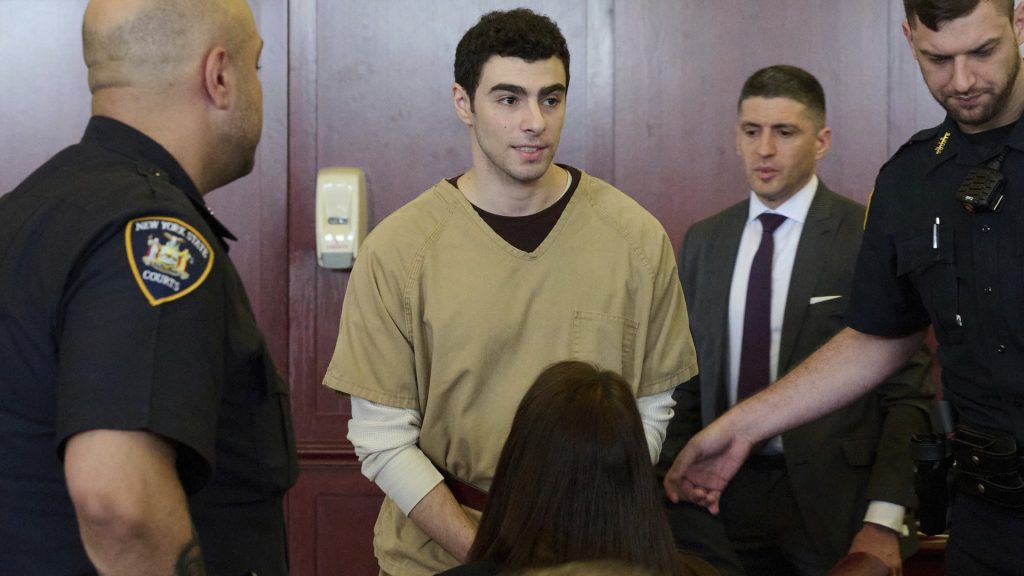Luigi Mangione’s defense seeks to have death penalty charge dismissed

On Saturday, the defense counsel for Luigi Mangione asked a federal judge to dismiss several charges related to the case. One of those charges, levied by the Trump administration, carries the death penalty.
Mangione’s attorneys on Saturday asked a federal judge in New York to dismiss several charges that were brought against their client in a federal grand jury indictment from April. Among the charges are murder with a firearm, another firearms-related offense and two counts of stalking.
At the time of the indictment, Attorney General Pam Bondi directed federal prosecutors to pursue the death penalty against Mangione, who is accused of murdering the former CEO of UnitedHealthcare outside a Manhattan hotel in December 2024. Bondi called the attack a “cold-blooded assassination” and said the decision aligns with President Donald Trump’s renewed push for federal capital punishment.
Because capital punishment has been abolished in New York, Mangione can only face the death penalty at the federal level.
Could missteps in Mangione’s arrest void charges?
Now, Mangione’s defense is asking that some of those charges be tossed out, due to the circumstances surrounding his arrest.
They argue that statements Mangione provided law enforcement following his arrest should not be included in the case because the officers did not read their client his rights before he was questioned.
According to Corinna Barrett Lain, a professor at the University of Richmond School of Law and author of “Secrets of the Killing State: the Untold Story of Lethal Injection,” two situations are required if Miranda rights are to be afforded –– the suspect must be in custody and in the process of an official interrogation.
“Interrogation under Miranda is any statements or actions that the police know are reasonably likely to lead to an incriminating response,” Lain told Straight Arrow News. As such, the officers who arrested Mangione could have asked innocuous questions to build rapport before he began divulging incriminating statements of his own accord.
Additionally, if Mangione were in custody when the officers began questioning him, they should have read him his rights.
Mangione was taken into custody in Pennsylvania after authorities said a McDonald’s employee recognized him as the person of interest seen in images related to the shooting death. When police arrived on the scene, they questioned Mangione.
According to court documents, Mangione “started to shake” when asked if he’d recently been in New York City. Authorities said at first, he lied about his identity. The officers told Mangione he would be arrested if he lied about his name, at which point he confessed to lying and told them his true identity.
Aside from that, the exact timeline of events surrounding Mangione’s arrest and the way in which he was questioned remains vague. So it’s unclear if the judge will dismiss the charges.
A search warrant for the backpack
The attorneys also contend that the officers did not have a search warrant for the backpack that allegedly held the weapon and ammunition used in the murder. Lain explained that Mangione might have waived his rights if he consented to having his backpack searched.
If he didn’t, though, and the backpack was not physically on Mangione’s person but on the floor next to his chair at the McDonald’s in which he was arrested, police would’ve needed a warrant.
“There are cases where a woman is carrying a purse, and the police have probable cause to search the woman. The courts will say, ‘Well, OK, the purse is a part of her,’ Lain said. “But where the purse or the backpack is not physically a part of them, but is just next to them –– they might have probable cause to seize the backpack, but they would need to get a warrant to actually search it.”
Is stalking a crime of violence?
Mangione’s attorneys are also asking that a federal charge which carries the death penalty be thrown out –– murder committed with a firearm as part of other “crimes of violence.” The defense is arguing that in their client’s case, the other crime is stalking, which is not considered a crime of violence.
For Lain, the issue falls into a legal gray area.
“So if you want to know if something’s a crime of violence, you would normally look within the code section,” Lain said, adding that stalking falls into the larger federal section on domestic violence. “And interestingly, [stalking] falls between sexual exploitation, that’s chapter 110, and shipping offenses — that’s chapter 111. So it’s not firmly embedded in some violent crime section.”
Lain explained that stalking can include numerous caveats that reach different ends, including intent to kill, injure, harass, intimidate or place under surveillance. Additionally, the behavior could have one of two results on the victim –– causing reasonable fear of death or bodily injury, or causing severe emotional distress.
“You could violate stalking by having these contacts or placing someone under surveillance with the intent to harass them or intimidate them,” said Lain. “Yeah, it’s against the law, but is it a crime of violence? No.”
Categorical vs. applied definitions of the law
In death penalty statutes, Lain said, the question often comes down to categorical definitions of the law, versus applied definitions.
“What happens then is you really have to look at this categorically. If you’re asking the question of, categorically, is this a crime of violence? It’s not,” Lain said. “Now, as applied, it could be a crime of violence, and my guess is that that’s going to be something that gets litigated.”
She added, “I think you could fairly say that stalking falls into a gray area, that it is not categorically a crime of violence, but as applied, it could be.”
Lain stressed that a lot of the circumstances and specifics surrounding Mangione’s arrest are still not fully understood by the public, and it’s difficult to know how the federal judge might rule.
Brian Thompson, the former CEO of UnitedHealthcare, was shot and killed outside the New York Hilton Hotel in Manhattan by a masked gunman. Thompson had been scheduled to speak later that evening at UnitedHealth Group’s investor conference.
A multi-state manhunt followed the shooting, with surveillance footage capturing the suspect’s movements after the attack. The investigation eventually led police to a McDonald’s in Altoona, Pennsylvania, where a tipster reported that a man inside matched the description released by the New York Police Department. That man was later identified as Mangione.
The post Luigi Mangione’s defense seeks to have death penalty charge dismissed appeared first on Straight Arrow News.





